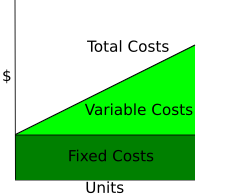
Variable costs are costs that change as the quantity of the good or service that a business produces changes.[1] Variable costs are the sum of marginal costs over all units produced. They can also be considered normal costs. Fixed costs and variable costs make up the two components of total cost. Direct costs are costs that can easily be associated with a particular cost object.[2] However, not all variable costs are direct costs. For example, variable manufacturing overhead costs are variable costs that are indirect costs, not direct costs. Variable costs are sometimes called unit-level costs as they vary with the number of units produced.
Direct labor and overhead are often called conversion cost,[3] while direct material and direct labor are often referred to as prime cost.[3]
In marketing, it is necessary to know how costs divide between variable and fixed. This distinction is crucial in forecasting the earnings generated by various changes in unit sales and thus the financial impact of proposed marketing campaigns. In a survey of nearly 200 senior marketing managers, 60 percent responded that they found the "variable and fixed costs" metric very useful.[4]
The level of variable cost is influenced by many factors, such as fixed cost, duration of project, uncertainty and discount rate. An analytical formula of variable cost as a function of these factors has been derived. It can be used to assess how different factors impact variable cost and total return in an investment.[5]
- ^ Garrison, Noreen, Brewer. Ch 2 - Managerial Accounting and Costs Concepts, pp 48
- ^ Garrison, Noreen, Brewer. Ch 2 - Managerial Accounting and Costs Concepts, pp 51
- ^ a b Garrison, Noreen, Brewer. Ch 2 - Managerial Accounting and Costs Concepts, pp 39
- ^ Farris, Paul W.; Neil T. Bendle; Phillip E. Pfeifer; David J. Reibstein (2010). Marketing Metrics: The Definitive Guide to Measuring Marketing Performance, Upper Saddle River, New Jersey: Pearson Education, Inc. ISBN 0-13-705829-2. Content used from this source has been licensed under CC-By-SA and GFDL and may be reproduced verbatim. The Marketing Accountability Standards Board (MASB) endorses the definitions, purposes, and constructs of classes of measures that appear in Marketing Metrics as part of its ongoing Common Language in Marketing Project.
- ^ Chen, Jing (2016). The Unity of Science and Economics: A New Foundation of Economic Theory. Springer. doi:10.1007/978-1-4939-3466-9. ISBN 978-1-4939-3464-5.